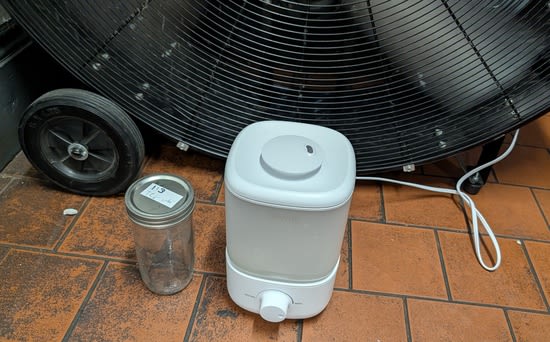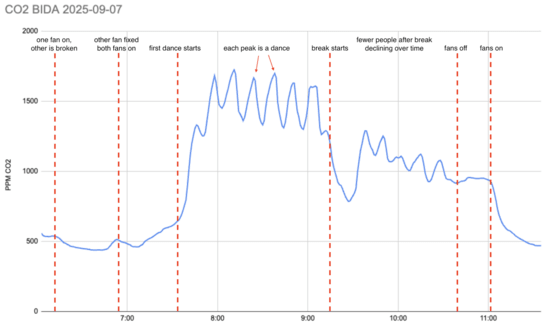Published on September 8, 2025 1:00 PM GMT
We planned to trial farUVC and glycol vapors at the BIDA contra dance last night: theseare two options (beyond masks and ventilation) for reducing infectiousaerosol inhalation. Both worked without issues.
I set up the far UVC Aerolamp onthe stage, slightly angled down, primarily aiming to clear the airabove the dancers:
And the glycol vapor, 1part TEG to 3 parts water by weight, in an ultrasonic humidifier.This went right in front of the intake fan: [1]
Logistically neither was much hassle, and we didn't get complaintsabout either. I would really like to measure how well they'reworking, but all the experiments I can think of (measuring thedecrease in viable airborne bacteria?) are serious investments.
I also measured CO2 levels with my M2000[2]:
These are high CO2 levels: this was our first dance back after thesummer and attendance was high. Looking at our attendance sheet, Icount 265; I'd guess occupancy peaked at ~230 since some people leaveearly, others arrive late, and some people are in the entryway andbathroom.
One thing you'll notice on that chart is that we kept the hall forsome extra time at the end to measure longer. We'd like to estimatehow much fresh air we're bringing in with the fans, and one way to dothis is to fill the air with something (in this case, the CO2 peopleexhale) and then measure how quickly it decays:
I had Gemini and GPT-5 fit an exponential decay constant, and bothgave me k=0.095. You can see it's not a perfect fit: it decays morequickly initially, and then decreases. I think this is because whilethe room has some mixing (with ceiling fans), it's not perfectlymixed.
With primary dimensions of 62x47ft and a height of ~20ft, I get ~5,600CFM (62 47 20 * 0.095). At last night's (higher than usual)attendance this is 24 CFM/person.
The actual amount of fresh air people experience will vary a lotacross the hall: I measured in the corner farthest from the incomingair. Overall, then, I think this is an underestimate of the amount ofventilation the typical person is experiencing.
(A different reason why I'd like to know how many CFM we're getting isto estimate how much TEG tovaporize. I'd previously guessed 8,000CFM which still seems plausible: some portion of the air we'rebringing in is going to go in one door and out the other without verythorough mixing.)
Next step will probably be a survey to understand how the communityfeels about applying these regularly going forward.
[1] We lent the fan out during the summer, which we've never donebefore and generally try to avoid with our gear. It came back with abusted switch. Thanks to Al for fixing it, in about 25 minutes beforethe dance started!
[2] I also tried using Harris'Aranet4, but because I didn't realize I needed to switch it to 1-minsampling I didn't get very useful results.
Comment via: facebook, mastodon, bluesky
Discuss





